Thursday, January 14th 2016

AMD Announces Opteron A1100 Series 64-bit ARM Processors for the Datacenter
AMD marks a major step towards delivering choice and innovation in the data center with the launch of the AMD Opteron A1100 System-on-Chip (SoC), formerly codenamed "Seattle". Jointly with its software and hardware partners, AMD is accelerating time-to-deployment of ARM-based systems and driving forward ecosystem support for ARM in the data center.
"The ecosystem for ARM in the data center is approaching an inflection point and the addition of AMD's high-performance processor is another strong step forward for customers looking for a data center-class ARM solution," said Scott Aylor, corporate vice president and general manager, Enterprise Solutions, AMD. "The macro trend of convergence between networking, storage and servers is an important catalyst in this evolution. Customers now have access to 64-bit ARM processors from the only silicon provider that also has decades of experience delivering professional enterprise and embedded products."The AMD Opteron A1100 SoC represents a key milestone for establishing ARM in the data center as well. "The AMD Opteron A1100 processor brings a new choice in scalability across network infrastructure and data centers," said Lakshmi Mandyam, director of server systems and ecosystems, ARM. "AMD brings recognized expertise in the server and embedded markets, making them an ideal partner to deliver a 64-bit ARM processor with the impressive balance of performance and power-efficiency to address an increasingly diverse set of workloads."
The AMD Opteron A1100 Series SoC is the first 64-bit ARM Cortex-A57-based platform from AMD. Utilizing ARM Cortex-A57 processors with high-speed network and storage connectivity and outstanding energy efficiency, the AMD Opteron A1100 Series SoC delivers a balanced total cost of ownership for storage, web and networking workloads.AMD Opteron A1100 Series SoC specifications:
"The secret of the AMD Opteron A1100 SoC's appeal is not just the cores, it's everything around the cores," said Norman Fraser, CEO of SoftIron. "If you've got an application where you need to move large amounts of data around quickly, you're going to love it."
AMD is also collaborating with Silver Lining Solutions (SLS) to integrate SLS' fabric technology in innovative dense server designs featuring the Opteron A1100 Series, targeted at streaming, web, and storage workloads for cloud and hyperscale datacenters. The SLS Fabric Interconnect incorporates a low-latency, energy efficient 60Gbps switching fabric and is available as a PCI Express expansion card or a standalone ASIC for custom server applications.
"We are very excited about working with AMD to bring power efficient fabric-based computing to market," said Dr. Ping-Kank Hsiung, Managing Director of Silver Lining Systems. "Combining the efficient AMD Opteron A1100 processor with our unique fabric will help drive down costs and power requirements of hyper scale computing and storage."
In addition to silicon innovation, AMD has been instrumental in supporting the 64-bit ARM software ecosystem, a critical component to any new processor, and has been working closely with Enterprise Linux leaders Red Hat and SUSE on operating system and application support.
"Red Hat and AMD share a vision of building an open, standards-based software ecosystem for highly converged designs based on 64-bit ARM architecture. As one of the first participants in Red Hat's ARM Partner Early Access Program, AMD has been instrumental in the testing and porting of the world's leading enterprise Linux platform to 64-bit ARM architecture", said Ranga Rangachari, vice president and general manager, Storage, Red Hat. "The arrival of the AMD Opteron A1100 SoC represents a major milestone to the ecosystem interested in driving converged infrastructure for storage, networking, and compute."
The AMD Opteron A1100 SoC has been in advanced development with technology partners and customers for several quarters and is available in mass production quantities today.
"The ecosystem for ARM in the data center is approaching an inflection point and the addition of AMD's high-performance processor is another strong step forward for customers looking for a data center-class ARM solution," said Scott Aylor, corporate vice president and general manager, Enterprise Solutions, AMD. "The macro trend of convergence between networking, storage and servers is an important catalyst in this evolution. Customers now have access to 64-bit ARM processors from the only silicon provider that also has decades of experience delivering professional enterprise and embedded products."The AMD Opteron A1100 SoC represents a key milestone for establishing ARM in the data center as well. "The AMD Opteron A1100 processor brings a new choice in scalability across network infrastructure and data centers," said Lakshmi Mandyam, director of server systems and ecosystems, ARM. "AMD brings recognized expertise in the server and embedded markets, making them an ideal partner to deliver a 64-bit ARM processor with the impressive balance of performance and power-efficiency to address an increasingly diverse set of workloads."
The AMD Opteron A1100 Series SoC is the first 64-bit ARM Cortex-A57-based platform from AMD. Utilizing ARM Cortex-A57 processors with high-speed network and storage connectivity and outstanding energy efficiency, the AMD Opteron A1100 Series SoC delivers a balanced total cost of ownership for storage, web and networking workloads.AMD Opteron A1100 Series SoC specifications:
- Up to eight ARM Cortex-A57 cores with 4MB shared Level 2 and 8MB of shared Level 3 cache
- 2x 64-bit DDR3/DDR4 channels supporting up to 1866 MHz with ECC
- 2x 10Gb Ethernet network connectivity
- 8-lane PCI-Express Gen 3
- 14x SATA 6 Gb/s ports
"The secret of the AMD Opteron A1100 SoC's appeal is not just the cores, it's everything around the cores," said Norman Fraser, CEO of SoftIron. "If you've got an application where you need to move large amounts of data around quickly, you're going to love it."
AMD is also collaborating with Silver Lining Solutions (SLS) to integrate SLS' fabric technology in innovative dense server designs featuring the Opteron A1100 Series, targeted at streaming, web, and storage workloads for cloud and hyperscale datacenters. The SLS Fabric Interconnect incorporates a low-latency, energy efficient 60Gbps switching fabric and is available as a PCI Express expansion card or a standalone ASIC for custom server applications.
"We are very excited about working with AMD to bring power efficient fabric-based computing to market," said Dr. Ping-Kank Hsiung, Managing Director of Silver Lining Systems. "Combining the efficient AMD Opteron A1100 processor with our unique fabric will help drive down costs and power requirements of hyper scale computing and storage."
In addition to silicon innovation, AMD has been instrumental in supporting the 64-bit ARM software ecosystem, a critical component to any new processor, and has been working closely with Enterprise Linux leaders Red Hat and SUSE on operating system and application support.
"Red Hat and AMD share a vision of building an open, standards-based software ecosystem for highly converged designs based on 64-bit ARM architecture. As one of the first participants in Red Hat's ARM Partner Early Access Program, AMD has been instrumental in the testing and porting of the world's leading enterprise Linux platform to 64-bit ARM architecture", said Ranga Rangachari, vice president and general manager, Storage, Red Hat. "The arrival of the AMD Opteron A1100 SoC represents a major milestone to the ecosystem interested in driving converged infrastructure for storage, networking, and compute."
The AMD Opteron A1100 SoC has been in advanced development with technology partners and customers for several quarters and is available in mass production quantities today.

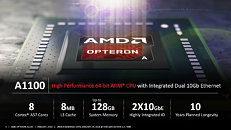
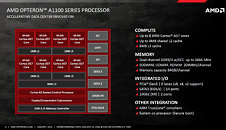
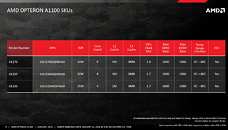
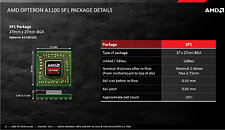
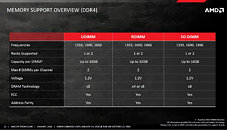
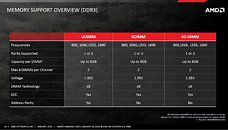
19 Comments on AMD Announces Opteron A1100 Series 64-bit ARM Processors for the Datacenter
Deploying 64 or maybe more cores could create a pretty powerful system.
I wonder though if so many cores can be deployed together and what is the performance of such a core?
I would like to know if these are coming to consumer space too Linaro's 96boards miniITX huskyboard look nice, but is it for consumers or industrial?
that is all
AMD Opteron 1150 has 8xA57 cores, 4MB L2 and 8MB L3.
Samsung Exynos 7420 has 4xA57 cores with 2MB L2, 4xA53 cores with 256KB L2 and no L3 cache.
Plus you get all the yummy stuff, like SATA-III controllers, eight PCI-E 3.0 lanes, pair of 10GbE ports etc. etc. etc.
You would be better off comparing Seattle with a comparable environment. AMD has it's work cut out for it. Over a year late, missing promised features, average performance envelope, and having to compete with entrenched competitors like Cavium's Thunder-X and Applied Micro's X-Gene at the higher....and lower end of the markets.All that (and more) has been available for some time in what amounts to a relatively budget server system.
The quad-core A1120 is a 25W chip at 1.7GHz, the A1150 is a 32W core at 2GHz, and the A1170 is a 32W chip at 2GHz. The last two flavors are both eight-core processors, but all three SKUs share the same memory capabilities and L3 cache. If AMD follows its past history on evaluating TDP, the 25-32W figures will represent a worst-case scenario for the chip, rather than its performance in a general workload. AMD historically rates TDP in the first fashion, while Intel uses the second — and that’s why you can’t usually directly compare TDPs between the two companies.
"
www.extremetech.com/extreme/221282-amds-first-arm-based-processor-the-opteron-a1100-is-finally-here
lets hope this brings them some revenue..
Why data centers? When a big company want a data center they will go to Oracle or IBM and thanks to open power foundation you can get cheaper systems from IBM partners, for the middle there is Intel with partners like HP, Dell and Lenovo and last but not least the small data centers where Intel still fight to control versus many many ARM supplier.
Wrong move AMD you had to put the money used to develop these CPUs in better place.
Qualcomm (principally smartphone and now, drones, and server but they are even newer than AMD in that sector, thus not carrying the same weight), Mediatek (mostly smartphones), Freescale(cortex A9 at the maximum) don't do server side, on the other hand you are right for Cavium and Applied Micro, so that make only 2(3) of the 5 "concurrent* mentioned, that's not what i call overflowing, not mentioning that AMD is already in that sector with the X86-64 Opteron.
AMD entering that sector might bring competition in it and also alternatives, depending the pricing, to the other brand already available
ofc any arm SOC can be used as a server cpu depending the demand (lots of home media server based on the Raspberry Pi 2 also ... )
who knows, that idea might not be so wrong and bring AMD some success they look after, at last i will pray for that, i wish them all the best.
(and i have a Mediatek SOC in my smartphone ... a intel CPU in my main and secondary rig and a Broadcom SOC in my Rpi2 )
* Xeon Phi's efficiency drops markedly as the job size increases. By all accounts Tianhe-2's Xeon Phi's remain idle most of the time. No big deal since the whole system was basically gifted to China by Intel (including the custom Xeon SKU being used). Does make for good marketing though.
** A CPUs floating point ops (even if using AVX /FMA to boost ops per cycle) is pitifulcompared to a GPGPU co-processor. AMD's own numbers are in the Opteron presentation notes (Take the comparison with Intel's Xeon with a pinch of salt obviously due to the constricted nature of the instruction sets they are using - thisand the previous link are more indicative of the current state of play)
thanks for the info @HumanSmoke
also that's why i did put in parenthesis "tho all the computing power come from the K20X"
Why do you do that?!
Are you happy to pay 250€ for an entry level 4 core CPU?!
Or do you rater pay 500€ for it??
I don't understand it...
AMD has found a nice and tries to make some good CPUs for that niche to get some money - and it's not right.
What the?!
Why do you always see the negative stuff when it comes to AMD and always highlight the good things with their competitors?! I really don't get it...
Must be some kind of sect or so...
Anyway:
It's an 8 core ARM with 2 Channel DDR3/DDR4 Memory controller, a massive amount of Cache (12MiB L2 and L3) and a massive amount of I/O things!
Not the low power things but high performance I/O stuff like PCIe 3.0 (x8) or a whopping 14 S-ATA 6G ports.
And not only that but also 2 10GBit Ethernet ports...
That this monster consumes a little bit more than a mobile performance chip with next to no I/O or rather just low power/low performance I/O Stuff wich are designed for use with no memory slots but rather memory onboard. That also saves power!!
This beast is less for computing and more for storage/database things. So do the other ARM Socs also have 14 S-ATA 6G Ports? And an x8 PCie 3.0 connector?
I think you underestimate the power modern high performance I/O stuff consumes!
That's where most of the power consumption comes from, not from the CPU cores...
The other ARM processors mentioned here are more for Supercomputer/Computing stuff that needs high memory bandwith and computing power. Doesn't seem that this AMD CPU has designed the A1100 series as a competitor for those...
But well, we are talking about AMD...
And when some people read the name AMD, they have to bash it...